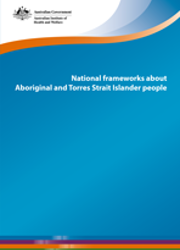Summary
This report details the outcomes of a project undertaken by the Australian Institute of Health and Welfare on behalf of the New South Wales Department of Education, Aboriginal Affairs to provide an overview of frameworks that describe Aboriginal and Torres Strait Islander people. It provides information about 10 national frameworks that fell within the agreed scope of the project. These were frameworks that: described Aboriginal and Torres Strait Islander people and/or services provided to them; had a health focus or covered a number of different topics including health; and were either a conceptual framework or a national reporting framework. Some of the frameworks included are currently active while others are no longer in use.
In this report, each framework is described according to a set of 8 topics: the reason for its development; its purpose; underpinning elements; reporting protocols; consultation processes; review processes; structure; and inclusion of Aboriginal and Torres Strait Islander principles.
Three of the frameworks were conceptual frameworks, with 2 of these focused on the topic of wellbeing. The third-which was under development at the time this report was prepared-takes a broad perspective, as it aims to consider statistical priorities and data gaps in relation to all key domains and aspects of Aboriginal and Torres Strait Islander people's world views.
The remaining 7 frameworks were national reporting frameworks with an agreed indicator set for reporting. The reasons for developing these frameworks varied. Though several aimed to report progress on reducing Aboriginal and Torres Strait Islander people's disadvantage compared with other Australians, each has a different and specific purpose, focus and way of considering the individual components within it. The nature and frequency of reporting on the indicator sets varies across each of the 7 reporting frameworks.
This project highlights several examples where the involvement of Aboriginal and Torres Strait Islander people was integral in shaping the frameworks. For example:
- Aboriginal and Torres Strait Islander people were involved in consultations on the development of the indicators for the Aboriginal and Torres Strait Islander Health Performance Framework (HPF) and the subsequent review of the HPF. The HPF was designed to measure the impact of the National Strategic Framework for Aboriginal and Torres Strait Islander Health (NSFATSIH). Aboriginal and Torres Strait Islander people were also consulted during the development of the NSFATSIH.
- Aboriginal and Torres Strait Islander people both conducted and participated in consultations to develop the Overcoming Indigenous Disadvantage (OID) reporting framework, and these processes involved Indigenous leaders, organisations and communities across Australia. Reviews of this framework also included consultation with Aboriginal and Torres Strait Islander people and organisations.
- Close partnerships with Aboriginal and Torres Strait Islander people (including the National Health Leadership Forum) were integral to the development of the Implementation Plan goals for the National Aboriginal and Torres Strait Islander Health Plan, with consultation undertaken both in relation to these goals, and to the Plan itself.
Preliminary material: Acknowledgments; Abbreviations
1 Introduction
- Terminology used in this report
2 Scope and methodology
- Frameworks in scope
- Methodology
3 Findings
- Why the frameworks were developed and by whom
- Underpinning principles and theories
- Protocols and practicalities associated with reporting
- Consultation
- Review
- Structure
- Inclusion of Aboriginal and Torres Strait Islander perspectives
4 Discussion
- Consultation
- Review
- Inclusion of Aboriginal and Torres Strait Islander perspectives
- Insights from overseas
- Conclusion
Appendixes:
Appendix A: Framework summaries
Appendix B: Material out of scope
Appendix C: First Nations Mental Wellness Continuum Framework
Appendix D: Māori Statistics Framework
Appendix E: Committees and groups referred tin this report
End matter: References; List of tables; List of figures



